Castle-Manor House of the Week - St Michael's Mount, Cornwall
August 29, 2012
St Michael’s Mount
Marazion, Cornwall, England, UK
OS Grid Reference: SW514298
Maintained by the National Trust
Websites: www.stmichaelsmount.co.uk; www.nationaltrust.org.uk/stmichaelsmount
(This castle was also featured on this blog on November 2, 2010 after my trip to the UK.)
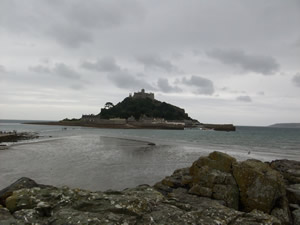 St Michael’s Mount, or simply the Mount, as it is known coloquially by locals, is a tidal island rising dramatically from the waters of Mount’s Bay, 400 yards off the coast of Cornwall. The castle and priory, as well as the tiny village located there are accessible by a granite causeway strewn with seaweed and algae between mid-tide and low water. At other times, it is necessay to hire a small boat to take you across. St Michael’s Mount, or simply the Mount, as it is known coloquially by locals, is a tidal island rising dramatically from the waters of Mount’s Bay, 400 yards off the coast of Cornwall. The castle and priory, as well as the tiny village located there are accessible by a granite causeway strewn with seaweed and algae between mid-tide and low water. At other times, it is necessay to hire a small boat to take you across.
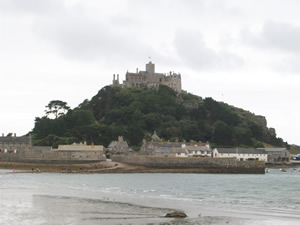 In Cornish, St Michael’s Mount is called Karrek Loes y’n Koes, which means “grey rock in the woods.” This name may reflect a folk memory from the time before Mount’s Bay was flooded, when it was surrounded by a thick wood and stood perhaps five or six miles from the sea. Both the Anglo-Saxon Chronicle and the Cornish legend of Lyonesse relate stories of a massive flood overtaking the area. In Cornish, St Michael’s Mount is called Karrek Loes y’n Koes, which means “grey rock in the woods.” This name may reflect a folk memory from the time before Mount’s Bay was flooded, when it was surrounded by a thick wood and stood perhaps five or six miles from the sea. Both the Anglo-Saxon Chronicle and the Cornish legend of Lyonesse relate stories of a massive flood overtaking the area.
St Michael’s Mount is also associated with the Cornish legend of the Giant Cormoran and Jack the Giant-Killer. The legend says that the giant lived on the Mount, and often waded ashore to dine on the nearby villagers’ cows and sheep. A local boy named Jack rowed out to the island one night in order to dig a deep pit while the giant slept. At sunrise, he blew a horn to wake the giant, who angrily stumbled down the hill, and being blinded by the sunlight, tumbled to his death in the pit.
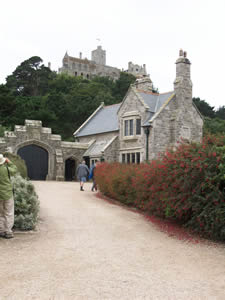 Ancient Roman historians believed the Mount was the island of Ictis, which had been an important center during the Iron Age for the Cornish tin trade. If true, it would mean the Mount is one of the earliest identified locations in the whole of western Europe and particularly on the island of Britain. Ancient Roman historians believed the Mount was the island of Ictis, which had been an important center during the Iron Age for the Cornish tin trade. If true, it would mean the Mount is one of the earliest identified locations in the whole of western Europe and particularly on the island of Britain.
According to another legend, during the 5th century, around 495, a vision of the Archangel Michael appeared here to some fisherman in order to warn them of the rocks. An ancient stone chair now stands at the entrance to the castle on the western side of the island, where the angel was said to have materialized. The fact that it was to fisherman that the angel appeared might be a nationalistic twist to the myth, but regardless, the Mount from that day forward was supposedly dedicated to the archangel St Michael.
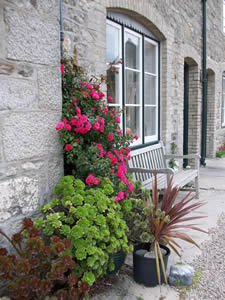 The Mount may have been the site of an earlier monastery in the 8th-early 11th centuries, but it is known for certainty that when the Normans conquered England in 1066 they were struck by the island’s resemblance to their own Mont-Saint-Michel in Normandy, France, which shares the same tidal island characteristics and the same conical shape. The Benedictine monks from Mont-Saint-Michel were invited by Edward the Confessor in the 11th century to build a small abbey on the Mount. The 12th century Abbot, Bernard le Bec, did finally establish a Benedictine priory there, building the stone church on the summit in 1135. It was consecrated by Robert, Bishop of Exeter in 1144. The Mount became a major pilgrimage destination through the Middle Ages, and four miracles are said to have happened there between 1262 and 1263. The Mount may have been the site of an earlier monastery in the 8th-early 11th centuries, but it is known for certainty that when the Normans conquered England in 1066 they were struck by the island’s resemblance to their own Mont-Saint-Michel in Normandy, France, which shares the same tidal island characteristics and the same conical shape. The Benedictine monks from Mont-Saint-Michel were invited by Edward the Confessor in the 11th century to build a small abbey on the Mount. The 12th century Abbot, Bernard le Bec, did finally establish a Benedictine priory there, building the stone church on the summit in 1135. It was consecrated by Robert, Bishop of Exeter in 1144. The Mount became a major pilgrimage destination through the Middle Ages, and four miracles are said to have happened there between 1262 and 1263.
In 1193, the Mount was seized by Henry Pomeroy and his men, who disguised themselves as pilgrims, on behalf of Prince John, the Earl of Cornwall, later King John, while his brother Richard I was on crusade in the Holy Land.
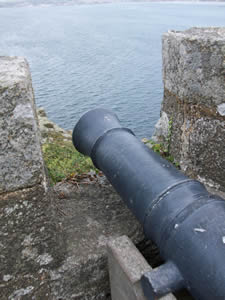 In 1385, the first English prior, Richard Auncell of Tavistock, was installed. However, under the dissolution of the alien houses by Henry V in 1414, the French monks were dispossessed of the priory, and in 1424 it was given to the abbess and Convent of Syon at Isleworth, Middlesex. In 1385, the first English prior, Richard Auncell of Tavistock, was installed. However, under the dissolution of the alien houses by Henry V in 1414, the French monks were dispossessed of the priory, and in 1424 it was given to the abbess and Convent of Syon at Isleworth, Middlesex.
In 1473, during the War of the Roses, John de Vere, the 13th Earl of Oxford seized St Michael’s Mount with only 400 men, and then held it during a siege of 23 weeks against Edward IV’s 6,000 troops. But after another long siege the following year he was forced to surrender to the king.
In 1497, Perkin Warbeck occupied the Mount during his ill-fated rebellion, and left his wife Katherine Gordon there for her safety.
The abbey was absorbed into a fortress at the Dissolution of the Monasteries (1536-1541), when Henry VIII set up a chain of coastal defenses to counter an expected attack from France.
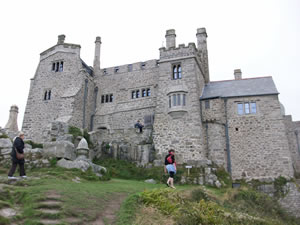 In 1549, Humphry Arundell, the governor of St Michael's Mount, led the Prayer Book Rebellion. He and the other rebel leaders were eventually captured and hung, drawn, and quartered at Tyburn. In 1549, Humphry Arundell, the governor of St Michael's Mount, led the Prayer Book Rebellion. He and the other rebel leaders were eventually captured and hung, drawn, and quartered at Tyburn.
In 1588, the first beacon lit to warn of the arrival of the Spanish Armada was lit on the Mount.
In 1599, during the reign of Queen Elizabeth I, Robert Cecil, the Earl of Salisbury purchased St Michael’s Mount. His son then sold it to Sir Francis Basset in 1640. During the Civil War, Sir Francis’s brother, Sir Arthur Basset, defended the Mount against parliamentary forces until July 1646.
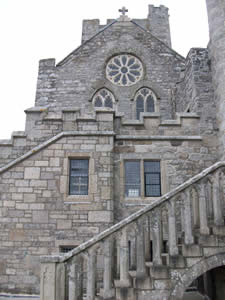 In 1647, Colonel John St Aubyn was nominated to be the Captain/Governor of the Mount. In 1659, he purchased the property from the Basset family and he and his descendants subsequently transformed the Mount from a fortress into a magnificent home. King Charles II made Colonel St Aubyn’s son a baronet, the first of five baronets all named Sir John. In 1727, the third baronet rebuilt the harbor, and St Michael’s Mount became a flourishing seaport. Around the year 1750, the Lady Chapel was converted into two drawing rooms. Not long after, in 1755, the Lisbon earthquake caused a frightening tsunami, which struck the Cornish coast, over 1,000 miles away, causing great loss of life and property. At the Mount, the sea rose six feet in 10 minutes before ebbing, and for five hours continued to rise and fall. In 1647, Colonel John St Aubyn was nominated to be the Captain/Governor of the Mount. In 1659, he purchased the property from the Basset family and he and his descendants subsequently transformed the Mount from a fortress into a magnificent home. King Charles II made Colonel St Aubyn’s son a baronet, the first of five baronets all named Sir John. In 1727, the third baronet rebuilt the harbor, and St Michael’s Mount became a flourishing seaport. Around the year 1750, the Lady Chapel was converted into two drawing rooms. Not long after, in 1755, the Lisbon earthquake caused a frightening tsunami, which struck the Cornish coast, over 1,000 miles away, causing great loss of life and property. At the Mount, the sea rose six feet in 10 minutes before ebbing, and for five hours continued to rise and fall.
Before the beginning of the 18th century, little is known of the village on the Mount except that it had a few fisherman’s and monastic cottages. Following the improvements to the harbors, the town grew so that by 1811, 53 houses and four streets surrounded the base of the mount. 1821 saw the peak in population at 221 people. In 1846, Queen Victoria landed at St Michael’s Mount harbor from the royal yacht. At the top of the landing stage, a brass inlay of her footstep is visible. The footstep of King Edward VII can also been seen near the bowling-green. However the village went into decline after major improvements were made to Penzance’s harbor across the bay, and the extension of the railway in 1852 to Penzance, which is now England’s most western city.
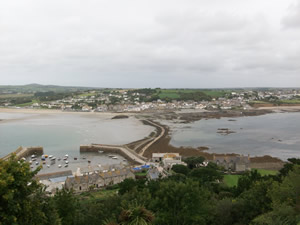 In 1839 the St Aubyn baronetcy lapsed when the 5th baronet’s illegitimate son, James St Aubyn, succeeded him. But in 1866 Edward St Aubyn was made a baronet, and in 1887 his son John St Aubyn became a baron, Lord St Levan. In 1873-1874, the Victorian Wing of the castle was built, where the family still lives today. In the late 19th century, the skeleton of an anchorite was supposedly found in a chamber below the chapel, which had become his tomb. In 1839 the St Aubyn baronetcy lapsed when the 5th baronet’s illegitimate son, James St Aubyn, succeeded him. But in 1866 Edward St Aubyn was made a baronet, and in 1887 his son John St Aubyn became a baron, Lord St Levan. In 1873-1874, the Victorian Wing of the castle was built, where the family still lives today. In the late 19th century, the skeleton of an anchorite was supposedly found in a chamber below the chapel, which had become his tomb.
During World War II, the Mount was fortified against invasion, and indeed three pillboxes can still be seen today.
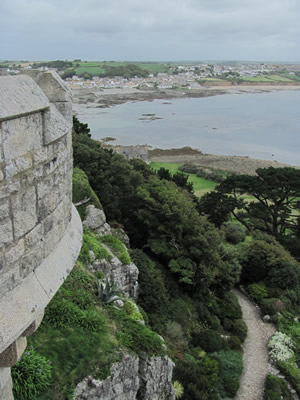 In 1954, the 3rd Baron St Levan gifted most of St Michael’s Mount, along with a large endowment, to the National Trust. However, the St Aubyn family still retains a 999-year lease to inhabit the castle, and a license to mange the public viewing of its historic rooms, which is managed in conjunction with the National Trust, who ensures the Mount’s preservation and conservation. In 1954, the 3rd Baron St Levan gifted most of St Michael’s Mount, along with a large endowment, to the National Trust. However, the St Aubyn family still retains a 999-year lease to inhabit the castle, and a license to mange the public viewing of its historic rooms, which is managed in conjunction with the National Trust, who ensures the Mount’s preservation and conservation.
St Michael’s Mount attracts thousands of visitors each year, including those interested in the spiritual, as it lies on one of Britain’s most prominent ley lines. Many relics are preserved in the castle and chapel, and on display, including armor and antique furniture.
Indeed, I had the great fortune to visit St Michael’s Mount with my husband in 2010. We greatly enjoyed our visit and both ranked the castle among the top three we visited while in the UK. Its magnificent location coupled with the grandeur of the buildings and its intriguing mix of old and new, easily made this a favorite tourist site. We spent a significant amount of time on the battlements staring out in all four directions from the island. To the south, lay the English Channel and further out the Atlantic Ocean, the skies low and hazy over the choppy, steel blue waves. In the distance to the east, we could just make out the shape of the Lizard Peninsula, at the tip of which lies England’s southernmost point. To the north, sat the small village of Marazion with its brightly colored cottages. And to the west rested the much larger town of Penzance, the end of the railway line and the most westerly major town in England, where a mild climate enables palm trees to grow along the coastline.
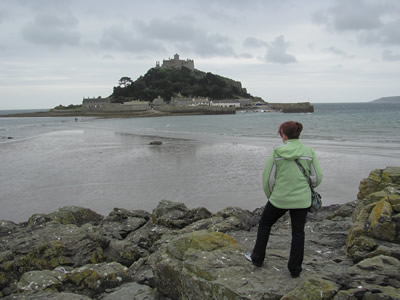 |